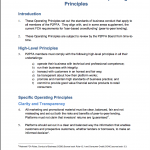Opportunities and Challenges in Online Marketplace Lending U.S. Treasury Report
On Tuesday, May 10, 2016 the United States Treasury Department published a white paper entitled “Opportunities and Challenges in Online Marketplace Lending.”
“There is a clear need for greater transparency in the market for borrowers and investors,” Treasury Counselor Antonio Weiss said Tuesday in a call with reporters. He said Treasury recommends that regulators form a group to examine oversight needs for the industry and figure out “where further regulatory clarity could benefit the market.”
This report and call to action comes on the heels of the resignation of Renaud LaPlanche, the founder and now former Chief Executive Officer and Chairman of Lending Club, the largest global marketplace lender. An internal review found a failure to disclose a personal interest in an investment fund the company was considering investing in. The review also found that he was among managers who had knowledge of abuses that were tied to the sale of some loans.
It has become clearer that marketplace lenders need to be more transparent about their business practices and some should be subject to additional oversight from U.S. regulators, according to a Treasury Department study released as the industry grapples with market turmoil and a scandal involving one of its leading firms.
The Treasury department said today in the released white paper/ report (attached) that companies in the burgeoning industry need to develop a public database for tracking data on their loans, and firms that lend to small businesses in particular should be subject to more federal consumer protection laws.
Treasury sought public comment on the marketplace lending industry to help government officials better understand the different business models and products being offered in July 2015. Treasury outlined six recommendations, including calling for online lenders to improve how transparent their products are to borrowers as well as investors and the need for them to employ consistent standards and disclosures.
You can read the full report here.







